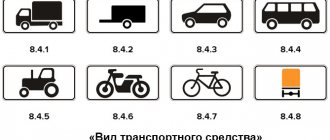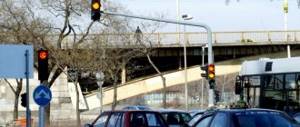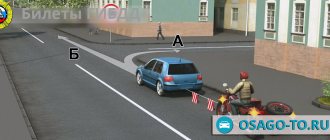Among the list of traffic rules identification signs, the “Spikes” sign was perceived ambiguously by drivers for a long time: the requirement to install it when using studded tires was not always considered mandatory. At the same time, studs have a significant impact on safety, and changes in traffic legislation could not fail to take this into account.
Until recently, the presence of the “Spikes” sign on cars with studded tires was mandatory, and its absence was subject to a fine of 500 rubles or a warning.
From December 8, 2021, the “Spikes” sign is excluded from the traffic rules (note – Government Decree No. 1414 of November 24, 2018). That is, now the presence of the “Spikes” sign on vehicles is not mandatory, and accordingly, a fine for its absence is no longer imposed.
However, there are quite good reasons why we recommend that drivers continue to mark their vehicles with the “Spikes” sign in the winter when driving on studded wheels. Below you will find answers to the following questions:
- Why was the mandatory use of the “Spikes” sign canceled?
- Why should you continue to use the “Spikes” sign?
- What size should the “Spikes” sign be and where is the best place to glue it?
- Additional information about the cancellation of the fine for the absence of the “Spikes” sign.
Why o?
When the “Spikes” sign was declared mandatory to designate cars with studded tires, the logic of the legislators was that a car with such tires brakes much more sharply. Therefore, the driver following you must be aware of your spikes in order to maintain a sufficiently large distance.
In fact, contrary to this logic, the braking distance of a car depends primarily on its weight, the presence of electronic safety systems and weather conditions. The mere presence or absence of studs on a tire, if it has any effect, is far from primary.
Perhaps 30 years ago the “Spikes” sign had some meaning, when everyone drove all-season tires and studs were quite rare. Then, probably, cars with spikes really braked noticeably sharper than all other cars. But nowadays this is no longer the case.
The “Spikes” sign has lost its original meaning, since today more than 70% of motorists, that is, the vast majority, drive studded tires. Therefore, if you need to mark some cars in traffic with winter tires, then it would be more logical to stick the sign on cars with Velcro rather than with studs.
Is there a fine for not displaying a “Studded” sign on a vehicle with studded tires? And is there a fine for displaying a “Spikes” sign when the tires are without studs?
As of December 8, 2021, the fine for the absence of the “Spikes” sign has been abolished. By Decree of the Government of the Russian Federation of November 24, 2018 No. 1414, changes were made to the Traffic Rules.
From paragraph 8 of the “Basic provisions for the approval of vehicles for operation...” the “Spikes” sign is excluded.
There is now no obligation to install such a sign on a vehicle with studded tires. And there is no punishment for the absence of such a sign either.
Below is information that was relevant from 04/04/2017 to 08/12/2018.
The article has not been completely removed from the site so that, if desired, drivers can read that from 04/04/2017 to 08/12/2018 a fine was established for the absence of the “Spikes” sign on vehicles with studded tires.
Now we will sort out the following questions:
Comments
Max 11/10/2017 09:35 Nonsense.
Part 1 art. 12.5 of the Code of Administrative Offenses of the Russian Federation can only be applied for malfunctions and conditions under which the operation of the vehicle is prohibited. The application to the Decree of the Council of Ministers - Government of the Russian Federation of October 23, 1993 N 1090 “On the Rules of the Road” List of malfunctions and conditions under which the operation of vehicles is prohibited there is nothing about the “Sh” sign. Reply | Reply with quote | Quote
Admin 11/10/2017 20:00 Your knowledge is outdated. Try to read what you called nonsense. Then find the latest edition of the List of Faults. If you do everything correctly, you will understand that you were wrong to call the article nonsense. To make it easier for you to understand, here is a link to an article about the changes that resulted in a fine for not having a “Spikes” sign:
Reply | Reply with quote | Quote
Andrey 10.29.2018 20:26 in the “List of faults and conditions under which the operation of vehicles is prohibited” a condition about the “Spikes” sign has been added. I opened a fresh list in the consultant and did not find anything about the sign Ш-...
Reply | Reply with quote | Quote
Admin 10.30.2018 21:30 There is a reference norm, i.e. not stated directly. Paragraph 7.15(1) of the List of Faults states: “There are no identification marks that must be installed in accordance with paragraph 8 of the Basic Provisions for the Admission of Vehicles to Operation...”.
Reply | Reply with quote | Quote
Thief 11.11.2017 14:20 So can I glue it under the tint?
Reply | Reply with quote | Quote
Irzhan 21.11.2017 14:44 Thank you, I don’t even see the point of checking you yet. But reading your articles is very necessary. Competently.
Reply | Reply with quote | Quote
Mikhail 12/29/2017 15:38 Can I stick it on the inside of the trunk lid? Also the back
Reply | Reply with quote | Quote
Tatyana 04/20/2018 10:48 I drove around all winter without a sign (I kept a sticker in the glove compartment - just in case there was a “fireman”. No one stopped me even once, and they didn’t make any comments either (once they stopped me, they indicated that the right headlight was not on). I didn’t hear , so that someone would be fined or even get to the bottom of it.
Reply | Reply with quote | Quote
Natalya 04/20/2018 22:53 My “Ш” sign was torn by the wind and was poorly glued. I thought that if they stopped me and said that the sign did not meet the requirements, I would say that bears had just attacked and torn me to pieces. But no one stopped me even once. So I drove all winter with half a sign
Reply | Reply with quote | Quote
Yuri 04/25/2018 09:59 I don’t have the “Ш” sign installed, because... tires without studs, i.e. "Velcro". However, during the entire season they never stopped and checked whether this was so...
Reply | Reply with quote | Quote
Alexander 04/26/2018 08:23 I didn’t glue the sign and didn’t even buy it. Several times during the winter, we were stopped at traffic police posts, but no one remembered this sign. A friend's letter was stolen several times in the parking lot, torn right off the glass. None of the friends were fined, but some were given a warning) )
Reply | Reply with quote | Quote
Sergey 02/20/2019 15:37 Question: the spike sign is in the glove compartment. If you come across an inspector who wants to issue a fine, how much time do you have to stick a spike sign before the inspector changes his mind?) Previously, they were fined for non-lighting bulbs, but there were 40 minutes to correct the problem (if I’m not mistaken)
Reply | Reply with quote | Quote
Admin 02/26/2019 22:17 Sergey, sorry, the article contained outdated information. On February 26, 2019, the article on the website was corrected. As of December 8, 2018, the obligation to install the “Spikes” sign on vehicles with studded tires has been cancelled. The fine has also been cancelled. Therefore, there is no need to stick this sign on the vehicle.
Reply | Reply with quote | Quote
Update list of comments
Add a comment
JComments
Why then stick the “Spikes” sign on your car?
The use of studded tires in winter created not only safer and more comfortable conditions for drivers and passengers of such “re-shod” cars, but also certain problems for other road users, especially those driving behind.
The main danger from cars with “spikes” is small crushed stone, which can fly out from under the studded wheels and damage the car driving behind, or even injure the driver. And a spike flying out of a tire can also seriously damage the windshield.
It is for the reasons mentioned above that we recommend that all conscious drivers continue to mark their cars with the “Spikes” sign when using studded tires.
By the way, experienced motorists can recall cases when traffic police inspectors concluded that cars colliding “in single file” on a slippery road were mutually at fault only because the car ahead on spikes did not have the “Spikes” identification mark installed. And no appeals to the fact that the rear car did not keep the required distance helped.
Another thing is that the use of new technologies in the production of car tires has made it possible to create models of winter tires that are not only not inferior in braking efficiency to studded ones, but also superior to them in many situations (studs or Velcro - which is better?). Therefore, an increased distance to the car in front must be maintained by cars with spikes too.
What if the car has Velcro?
When a vehicle is equipped with Velcro and not studded wheels, the presence or absence of the “Spikes” sticker does not concern such car owners for now. However, the option when the legislative body, with the light hand of the traffic police, resumes consideration of this issue, is very likely.
On the other hand, the introduction of a mandatory sticker with the “Ш” symbol for cars with Velcro would be quite logical, because the lip system, along with studded tires, provides a car with a shorter braking distance on an ice-encrusted road.
By the way, tests have proven that at low temperatures, the braking distance of a car with Velcro will be even shorter than that of a studded one. Accordingly, other road users must be warned in order to avoid unpleasant situations.
The main rule to follow when changing seasons:
- the “Spikes” sign on the car must appear simultaneously with the replaced summer set of tires;
- The law prohibits the use of a car with summer tires in winter.
The law also prohibits the use of studded wheels in the summer. The remaining months are the period in which the car owner himself must determine which wheels to use and he must do this based on weather conditions.
It is worth noting that in addition to the main legislative body of the country, there are also local legislators who can adopt a regional regulatory act that can either reduce or increase the periods of use of a certain type of rubber. After all, the duration of winter and summer in a region with a warm climate differs from the region where winter weather prevails.
At the same time, neither the traffic rules nor the laws provide for the responsibility of the car owner for operating the vehicle on summer tires, but with the presence of the “Spikes” sign on the glass.
This means that when the sticker remains on the glass in the summer and the set of studded wheels is removed, no one will be able to issue a fine. Therefore, there is no need to suffer and peel off and re-glue the sign in place every few months. And it is strongly recommended not to remove the sticker even in summer with new tires.
After all, none of the motorists driving behind can predict whether the car in front is equipped with spikes or not. Therefore, they will have to keep a safe distance with a margin to prevent a collision in the event of a sudden stop of the car.
What size should the “Spikes” sign be and where should it be placed?
Before the abolition of the mandatory use of the “Spikes” sign, with the beginning of the winter season in car dealerships, the stock of stickers with its image was often insufficient.
In this regard, the independent production of a sign was very relevant and many car enthusiasts needed information about the shape, size and color scheme of the sign.
- In accordance with the old version of the Road Traffic Rules, the “Spikes” sign is an equilateral triangle with the letter “W” inside it.
- The triangle is positioned with the apex up, and the length of the side is at least 20 cm.
- Along the sides of the triangle there is a border, the width of which is ten percent of the length of the side.
- Color scheme: the sign has a white background, a red border, and the letter “Ш” is black.
Where can I download the “Spikes” sign and how to print it correctly?
If you have the opportunity to use a color printer, then the “Spikes” sign can then be printed. It is advisable to do this on thick paper, for example, photo paper with a density of up to 150 g/m2, otherwise the sign will turn out to be short-lived.
If only a black and white printer is available, then we suggest, and the printout will need to be modified: use a brush with red paint or a red felt-tip pen to color the edge of the sign.
Where should the “Spikes” sign be placed?
The “Spikes” sign must be placed “behind” motor vehicles. Most often, it is glued in the upper corner of the rear window of the car on the inside - this place is convenient both for informing the driver driving behind and for ensuring the durability of the sign itself.
However, other installation locations do not contradict the traffic regulations, for example, on the bumper or on the rear trunk lid. Only in this case will the sign be exposed to precipitation and may quickly become unusable.
As for the use of a homemade “Spikes” sign of non-standard sizes, it should not be made smaller than the recommended minimum, but a significantly larger sign is also undesirable - when installed on the rear window, this may unacceptably restrict the driver’s visibility.
Where should I glue it?
In paragraph 8 of the Basic Provisions it is noted that the “Spikes” notification sticker may be located on the rear panel of the body or window of the car. The owner of the car determines the location of the marking element at his own discretion.
According to experienced driving school instructors, the light element with the image of the letter “W” is clearly visible from the upper corner of the rear window. If there is tinting, a sign warning about studded tires is glued to the outside. Transparent glass allows the placement of a marking element from inside the cabin.
This is interesting: Review of Mercedes-Benz GLK
When replacing winter tires with summer tires, it is not necessary to remove the corresponding sticker. This situation is not considered an offense. However, every road user is obliged not only to comply with traffic rules, but also to treat other motorists with respect. In summer, it is recommended to remove the “Spikes” sign from the car.
On the abolition of the fine for the absence of the “Spikes” sign
Previously, the absence of the “Spikes” sign referred to malfunctions in which the operation of the car was prohibited. Therefore, the punishment for failure to comply with the requirement to install it was regulated by the relevant article of the Code of Administrative Offences:
| Article of the Administrative Code | The content of the article | Responsibility for violation |
| 12.5 part 1 | Driving a vehicle in the presence of malfunctions or conditions under which, in accordance with the Basic Provisions for the admission of vehicles to operation and the duties of officials to ensure road safety, operation of the vehicle is prohibited, with the exception of malfunctions and conditions specified in parts 2 - 7 of this article | Punishment: warning or administrative fine in the amount of five hundred rubles Cases are considered by: Internal Affairs bodies |
But since the current version of the traffic rules does not provide for the use of the “Spikes” sign, there is also no punishment for its absence.
By the way, in accordance with the Road Traffic Regulations, motorists are required to use winter tires from December to March. At the same time, by local legislation it can be either reduced or increased, because winter in Norilsk and Rostov proceeds differently.
Car enthusiasts often wonder whether the opposite situation is a violation: a “Spikes” sign installed on a car in the summer (more precisely, installed in the winter and not removed in the summer). The Rules do not say anything about installing a sign during a strictly defined period, and, therefore, this situation is not a violation, and there is no need to fear a fine. And the margin of distance that the driver driving behind will set in the presence of a sign will not hurt at all.
Why notify about studded tires?
Most regions of the Russian Federation are dominated by a harsh climate with frequent precipitation in the form of snow and heavy rains. Due to poor climatic conditions in the autumn-winter period, drivers are forced to install studded tires on their cars.
Car tires with metal studs improve vehicle cross-country ability in difficult weather conditions and prevent slipping on snow and ice-covered roads.
Not every motorist knows that studded tires pose a danger to all road users. Understanding and mutual respect on the road reduces the number of traffic accidents. The “Spikes” sign pasted on the body or rear window of the passenger compartment means that the car in front is equipped with tires with metal spikes.
The main reasons for installing a warning sticker include:
- Notifying traffic participants about the presence of studded tires on the vehicle ahead.
- Maintaining distance while driving. A car with studded tires has a shorter braking distance during emergency braking.
- Warning against possible damage. When driving at high speed, the number of wheel revolutions increases. Flying metal inserts can damage neighboring machines.
- Guilt in case of a traffic accident. The driver of a car moving in front with studded tires may be found guilty of an accident if the “Spikes” marking element was not installed on the car.
- Passing a technical inspection. The absence of the “Spikes” sign on a car with studded tires may result in refusal to issue a vehicle inspection ticket. Further use of the vehicle is prohibited.
This is interesting: How to properly dilute antifreeze concentrate? 7 recommendations and rules
The above-mentioned options for the development of various situations on the road can be costly for the car owner.










